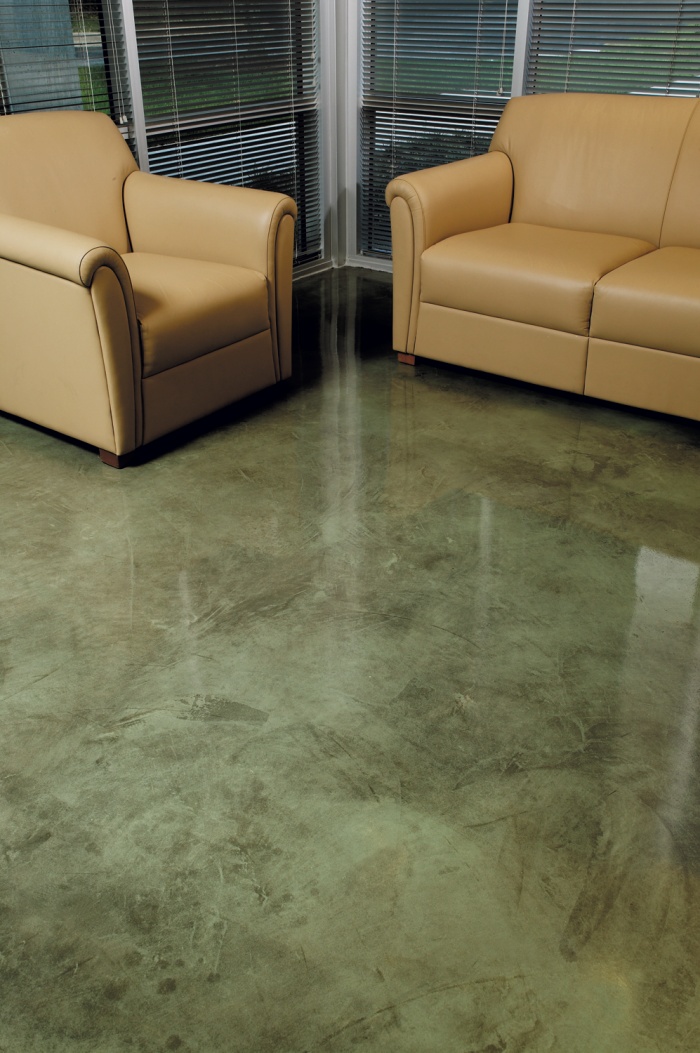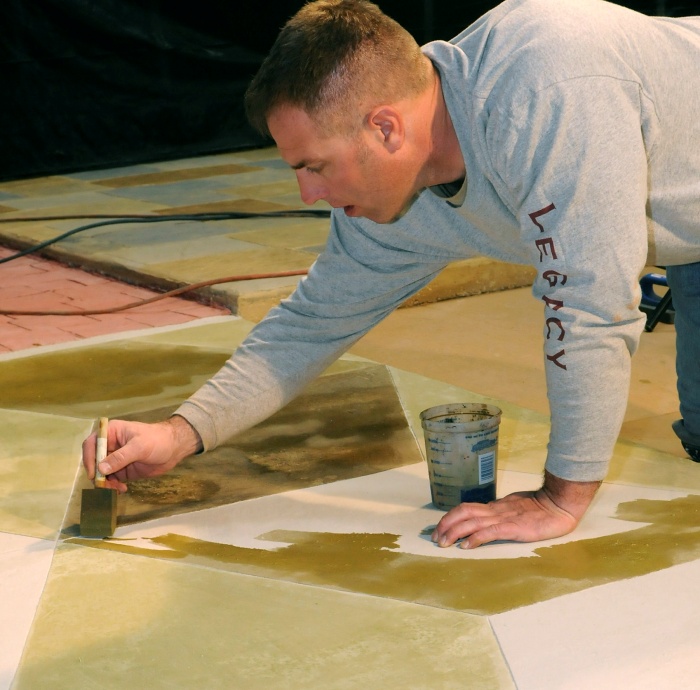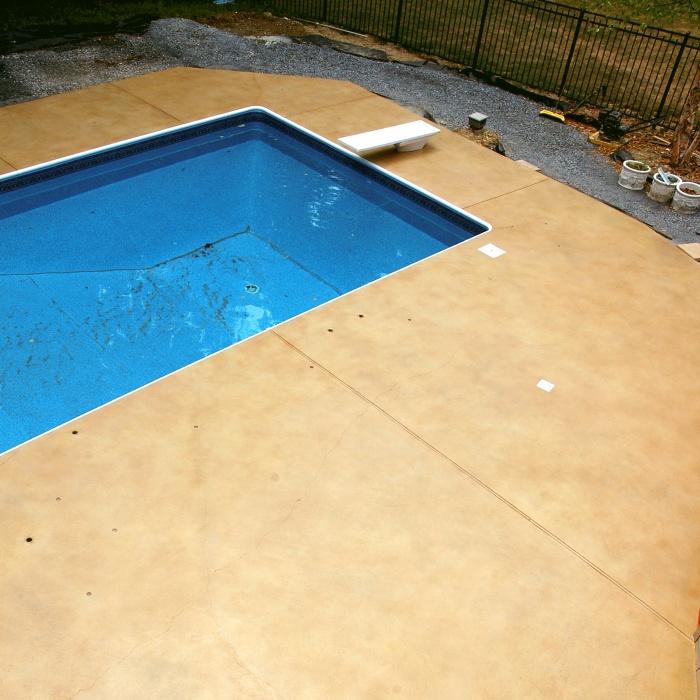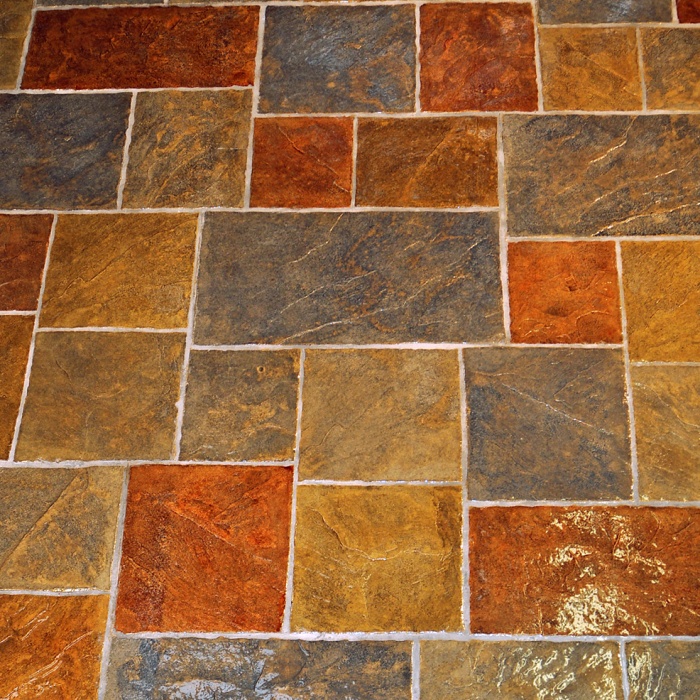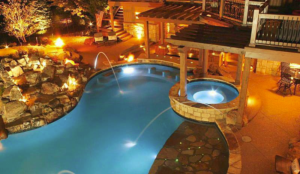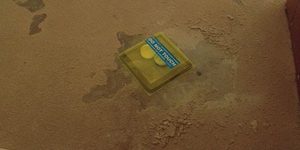Water-based stains hold tantalizing promise for the field of architectural concrete — low VOCs, low odor, simple application and cleanup, and bright hues not possible with reactive acid-based stains. But do they deliver the wearability, durability and ease of application that would help make concrete colored with water-based stains more appealing to customers?
How they work
To the newbie, water-based stains may seem to be just the “green” counterpart to acid-based or reactive stains. After all, you apply both in a similar manner. In fact, understanding the differences between how these two products function is the first step to setting accurate expectations for a water-based stain project.
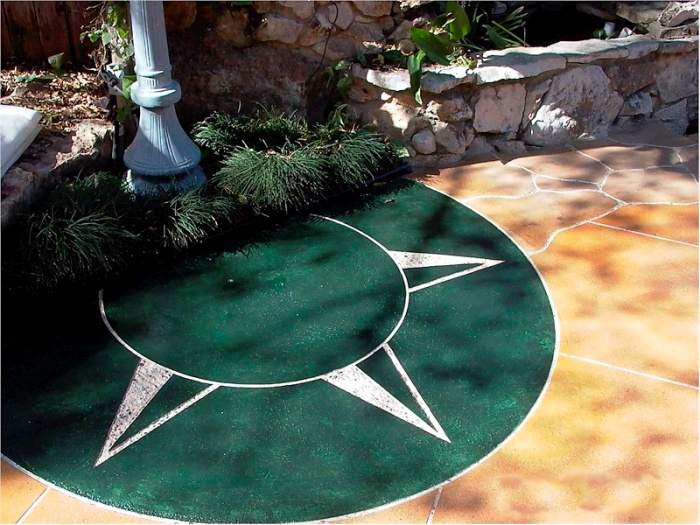
Acid stains work by reacting with the ingredients on the surface of the concrete to create a chemical change that results in variegated, natural-looking color. Water-based stains color concrete with pigments, not by chemical reactions. The most important ingredients are water, binder and pigment, according to Chuck Brunner Sr., owner of Smith Paint Products. The water is the carrier — it allows the material to flow. The binder, which can be, for example, an acrylic polymer or a silicate, locks or “glues” the pigment into the cement matrix. The pigment imparts the color.
In other words, water-based stains perform by flowing into the concrete pores and bonding with the cement, but they do not chemically alter the concrete itself. This means that by definition they are not permanent — if you don’t apply a sealer, they can wear away. So what are applicators and manufacturers doing to make sure that customers get and keep the vibrant colors they want?
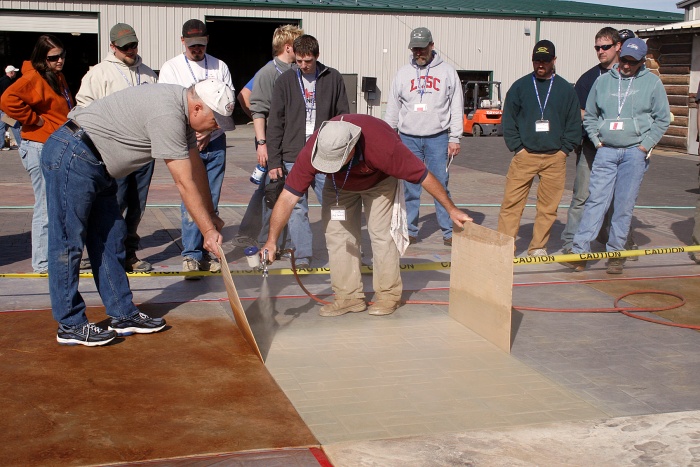
The 80-percent solution
“There are two key things about using water-based stains like our Rembrandt Polymer Stain,” says Barbara Sargent of Kemiko Concrete Products. “Problems come if there is not a proper surface profile or if there is not a good topcoat.”
Because the pigment must be carried into the pores, it is important that those pores be open to receive it. “You have to have a good profile for a successful outcome,” Sargent says. “It cannot be slick or smooth. You have to have profile for colors to bond.”
Cam Villar, director of marketing for the L.M. Scofield Co., agrees. “Surface prep is very important,” He says. “The surface must be absorptive but durable. If not, the stain will sit on the surface and the film strength is not strong enough to keep it intact.”
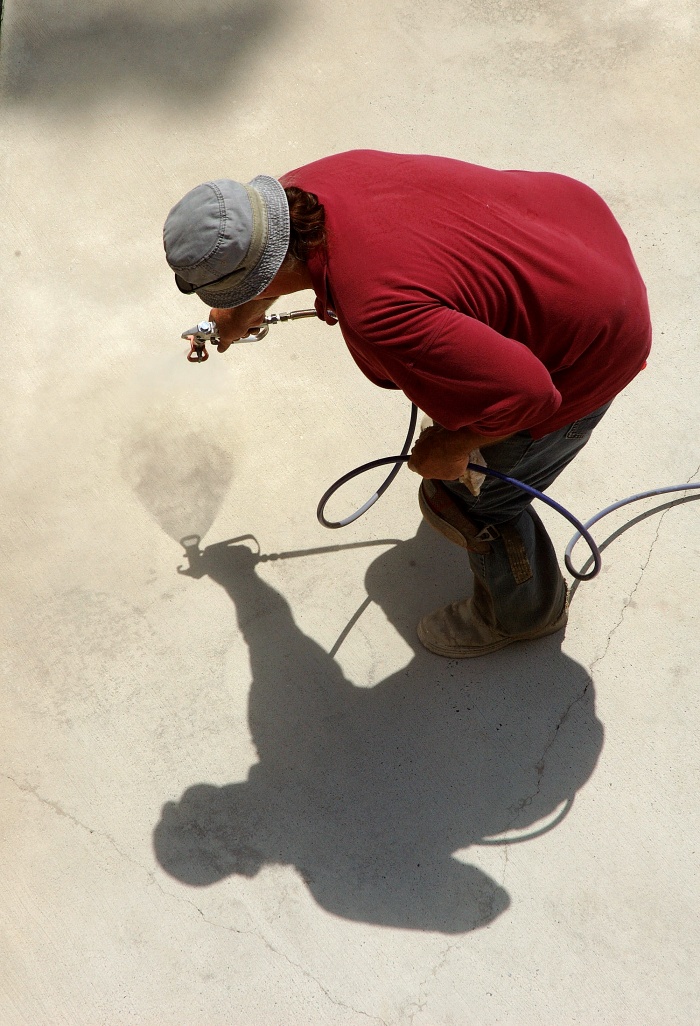
It is possible to trowel a surface so tightly that the stain fails to penetrate. If that happens, Ron Cottingham, vice president and general manager of Legacy Decorative Concrete Systems Inc., recommends opening the surface by sanding lightly or applying a profiling product.
Cottingham points out that the surface for either a water-based concrete stain or a reactive stain must be clean and free of curing agents, sealers, paints or other foreign materials. The work of other trades can be the culprit — for example, overspray from lacquering cabinets can impede penetration. “The main issue is the surface preparation,” Cottingham says. “There can’t be anything that would prevent water penetration.” He recommends a simple test. If concrete darkens when sprayed with water, that indicates that it is ready to accept stain.
Cleaning is essential
Cleaning the substrate is the most important phase of a stain installation, according to Brunner. He says his company’s product, Smith’s Color Floor, can actually adhere to polished concrete, sealers and even glass, though the more porous the substr
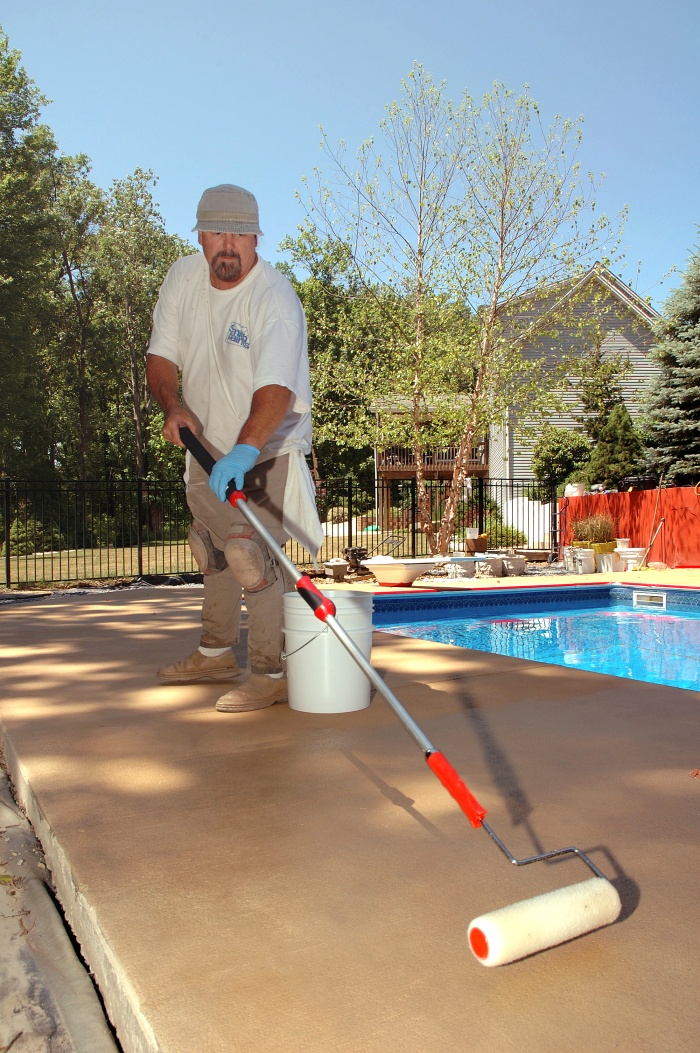
ate, the deeper the stain will penetrate into the surface. But he is adamant that the floor must be clean. “The biggest problem that we see is surface preparation,” he says. “Eighty percent of the time on a project should be spent on surface preparation, including taping and masking walls.” He recommends applying a cleaner and buffing the floor with a Mal-Grit abrasive brush. The objective is not only to get calcium hydroxide powder out of the pores and off the floor but also to remove curing agents, release compounds and other foreign materials.
“Water does not work well with powders,” he says. “You can’t just put the cleaner down and mop it up. You have to aggressively agitate the cleaner and then vacuum it up to remove latent materials lying on top of the concrete. It requires that you reach a point where the water you vacuum up looks as clean as the wash water you’re putting down.”
Another factor that can impact some water-based stains is acidity. Brunner explains that water-based products have a high pH — eight to nine and a half. “If you’re going over an acid job, you want to be sure it is totally dry and neutralized,” he says. “Otherwise the acid will knock the water-based right out of solution.”
Will it fade?
The biggest question about any color application is whether the original color will last. This is especially true for anything outside and exposed to harsh ultraviolet rays. Water-based concrete stains have a capacity for bright colors, but can they really stand up to sunlight?
Pigment selection plays the most important role in preventing fading, according to Smith Paints’ Brunner. “Most of what we sell are inorganic, iron-oxide pigments,” he says. “These are very lightfast and durable, as good as it gets when it comes to UV stability. We use the same phthalo-blue and phthalo-green that swimming pool paint has in it. They are very, very resistant to fading. We use reds that are automotive grade. They won’t turn brown or that pinkish brown that red fades to. We’ve chosen pigments that will last outside.”
Unlike many brightly colored water-based stains, Legacy’s Tinte d’Acqua water-based product is designed to replicate the mottled patina of reactive stains. Cottingham points out that the polymer formulation allows for a standard palette of 28 colors, compared to only eight for acid-based stains. “These colors are UV-stable,” he says. “They are not like reactive stain, where blues, greens or light yellows have a tendency to blacken under UV exposure.”

When loss of color does occur, it is more likely due to wear and abrasion than to UV exposure. Kemiko’s Web site states: “Rembrandt is formulated for both interior and exterior use. It has excellent UV stability and wearability, but should be protected with a clear topcoat for additional abrasion and chemical resistance and for easier cleaning.”
Essential step: the topcoat
That brings us to the critical final stage of the project — the sealer or topcoat. The right topcoat is required to prevent colors from being “walked off” or worn away. “Sealing is important for all decorative concrete applications,” says Cottingham. “The critical factor is designing and using the right product in the right place. Water-based stains are good for high-traffic, low-traffic, horizontal or vertical applications. The key is using the right sealer for the application.”
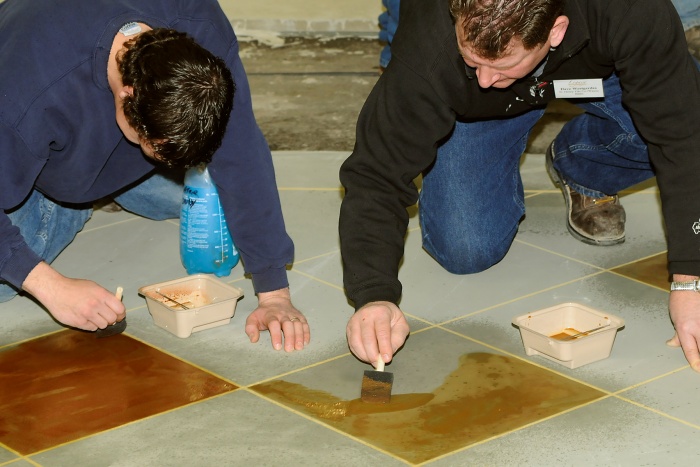
“The Tintura formulation is stable,” says Scofield’s Villar. “It needs to be protected from abrasion. If that is done, the project has a long service life. Our required sealer is a urethane with a UV-blocking mechanism. It blocks the infiltration of ultraviolet light, so the system is very UV-stable.”
Brunner concurs. “The choice of topcoat depends on what your application is,” he says. “How much traffic will it see? Will people be tracking in street dirt? Beach sand? Parking-lot grit? If anyone is going to walk on it, you’ve got to put protection on it.” Topcoats may be one- or two-component materials, acrylic urethane, polyurethane or epoxy.
Why the topcoat?
The bottom line is that a floor requires the right topcoat to preserve the beauty of any decorative concrete finish, including a water-based concrete stain. And, equally importantly, you must maintain that coat. “There is no miracle product — I wish there was,” says Cottingham. “I don’t know of a product you can simply apply and never have to maintain it.” He compares the sealer to the clear-coat on a new car. A car will look dingy and dull if you do not keep it clean and waxed. foot traffic or scraping furniture will dull a sealed concrete floor, but washing and waxing can restore the gloss. “A dull look doesn’t mean the sealer or the color is gone,” Cottingham continues. “It just needs maintenance. And the higher the gloss the more maintenance is required.”
System approach
Manufacturers are improving the reliability of water-based stains by developing systems of products that work together. Scofield, for example, has engineered its products to optimize the performance of each component and avoid negative interactions. “There is no guarantee, when you start mixing and matching competing products, that they will work together,” Villar explains. “A family of products — curing compounds, stain, sealer — can be engineered to work together. We know our products within each system are totally compatible, that there are no ingredients that will negatively impact curability, color or penetration.”
Contractors can ensure the success of their water-based stain projects by selecting products designed for their specific applications — interior, exterior, heavy traffic or harsh weather. They can further avoid problems by choosing a system of products proven to be compatible with each other. Finally, they should control what they can control, spending time on adequate cleaning, surface preparation and sealing.
